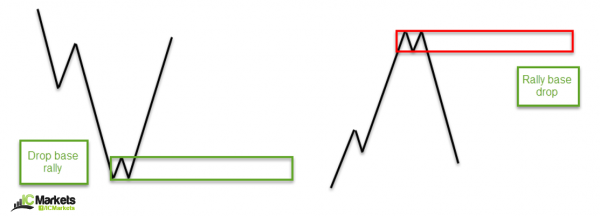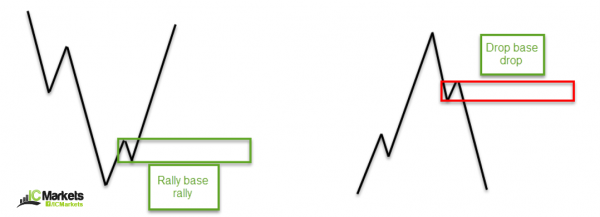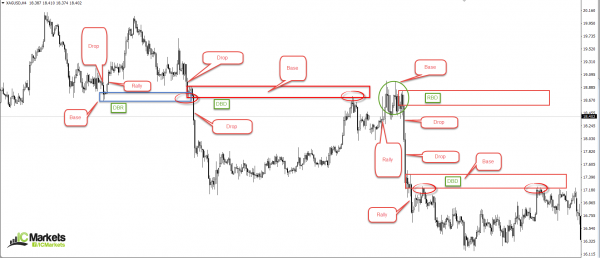Technical supply and demand is an approach based on price action. The general idea is to locate points on the chart where price has made a strong advance or decline. A demand zone is typically formed after a strong rally north. Conversely, a supply zone is effectively created following a noticeable move to the downside. This method, especially in the price action community, is widely popular.
There are four key areas of interest on the charts to look for:
The rally base rally, or ‘RBR’.
The drop base drop, or ‘DBD’.
The drop base rally, or ‘DBR’.
The rally base drop, or ‘RBD’.
- A ‘RBR’ demand zone primarily forms within an uptrend. From the image above, notice that price begins with an advance, and then moves into a consolidation phase (the base), which is then followed up with a continuation move to the upside. These barriers are effective at bouncing price, especially on the first time back.
- A ‘DBD’ supply zone is essentially the same formation as a ‘RBR’ area, but formed within a down trending environment. Referring to the image above, we can see that price begins with a decline in value, and then enters into a consolidation phase, which eventually follows through with a continuation move to the downside. The area formed is typically a stable zone in which one can look to short (sell) from.
- A ‘DBR’ demand is a zone which normally denotes a market bottom. As we can see from the image above, price was initially trending south until the piece began to bottom out (or base) and then reverse to the upside. The zone is usually an effective area to hunt for longs (buys).
- A ‘RBD’ supply is basically constructed in the same manner as the ‘DBR’ formation. The only difference is that instead of a market bottom, this pattern forms a market top and is used to hunt for selling opportunities.
Now that we have a basic idea of what to look for, here’s what some of the above noted zones look like on a live chart. Obviously, not all areas will give winning trades! Learning how to accept a loss is a large part of trading any methodology.
Additional points to consider
- Ideally, look for strong, obvious moves in the market that have taken out prior highs or lows. This demonstrates strength from the supply or demand zone.
- Higher-timeframe areas are said to be more reliable.
- Trading the first time back to a zone is, at least in our opinion, the highest probability trading point.
Difference between supply & demand and support & resistance
In just about every trading forum on the planet there’s debate among technicians as to whether there is any difference between supply and demand or support and resistance! There does not seem to be a single definitive answer to this puzzle, so we’ll just throw across our two pips’ worth on the subject…
Support and resistance is where one is able to see a number of failed attempts to move beyond a line/area that stretches back in history. However, in regards to supply and demand, we would essentially be looking for a strong move that has a fresh untouched base, rather than an area which has held firm on a number of tests.
In closing
There is no denying that trading supply and demand zones can be a profitable venture. Nonetheless, some traders prefer to confirm these zones using other technical tools, while others prefer to simply trade the zones naked, if you will.
Do yourself a huge favour and start scouring the charts and marking up these zones. What is also worth doing is noting the areas that worked and the ones that failed. Were there any tell-tale signs (apart from a news event) that could have forewarned its failure?
On the whole, this article has only really skimmed the surface of supply and demand analysis. There is a lot more to learn. In future articles, we’ll look at specific ways in which one can look to strengthen a zone such as: trend direction, price action confirmation, converging trendlines and so on…















